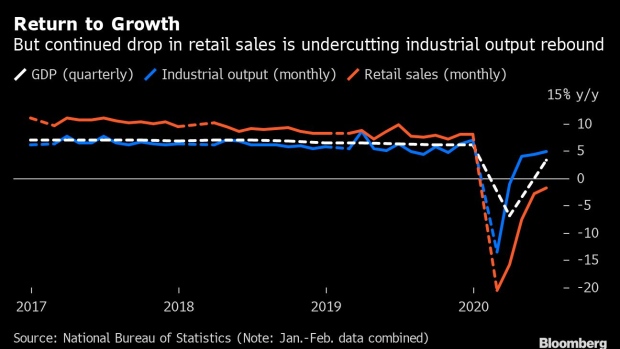Jul 16, 2020
China’s Rebounding Economy Now Hinges on Global Recovery
, Bloomberg News

(Bloomberg) --
China’s economic recovery is vulnerable to losing momentum as key trading partners from Japan to the U.S. struggle with resurgences of the deadly coronavirus and resort to fresh measures to control its spread.
While the world’s second-largest economy returned to growth in the second quarter amid relative success in containing the virus, much of that momentum relied on state-driven industry as consumers remain cautious.
“The Covid-19 situation continues to deteriorate in parts of the world,” said Ding Shuang, chief economist for Greater China and North Asia at Standard Chartered Plc. “This may weaken demand for China’s goods and services and is a main risk facing China’s economy.”
Officials nodded at the global risks after a slew of data Thursday showed a steady but uneven recovery.
Gross domestic product expanded 3.2% in the three months to June from a year ago, reversing a 6.8% decline in the first quarter and beating the median forecast of 2.4%. Output in the first half was still down 1.6% on the same period in 2019.
In an indication of the mixed recovery, industrial output rose 4.8% in June from a year earlier -- matching estimates -- yet retail sales shrank 1.8%, much weaker than a projected 0.5% increase. At the same time fixed-asset investment shrank 3.1% in the first half of the year, versus a forecast drop of 3.3%.
Liu Aihua, spokeswoman for the National Bureau of Statistics in Beijing, told reporters that the continued spread of the virus globally will remain a key constraint on any domestic recovery.
“It is difficult to restart the world economy and trade,” she said, adding that “the recovery of domestic demand is restricted to a certain extent currently.”
To be sure, exports and imports both rose in June, signaling a firmer footing at home and abroad and which some analysts say points to an improving picture still to come.
“I think the economic recovery in China will continue in the next few quarters, even when export growth is facing some headwinds.” said Bo Zhuang, chief China economist at research firm TS Lombard.
Still, data on global growth continues to disappoint. The U.K. economy’s 1.8% expansion in May was much weaker than expected. While a ZEW gauge of current conditions in Germany improved in July, confidence for the next six months slipped. The Bank of Japan warned that the economy remains in an “extremely severe situation.”
Hopes for containing the virus are being strained as infections continue to spread around the world, including places like Australia and Hong Kong where it had been brought under control, pushing global cases above the 13.5 million mark.
Australia’s second most populous state -- Victoria -- recorded its biggest spike in coronavirus cases Thursday, a week after it was placed into partial lockdown as it’s gripped by a second wave of infections.
New Lockdowns
The virus continues to flare across the U.S., with Texas reporting a record Covid-19 deaths and almost 11,000 new cases, and California seeing near-record surges.
None of which bodes especially well for China, which needs export growth to return to a sustainable expansion.
Private and external demand are the two biggest sources of uncertainty for the second half of the year.
Private companies cut back on investment in the first six months while spending by state-owned firms saw a big jump in June, rising 2.1% in the first six months after falling 1.9% through May. Manufacturing investment was down almost 12%.
A drop in the surveyed jobless rate drew caution that the reading doesn’t capture the full labor market and that tens of millions may still be out of work due to the pandemic.
What Bloomberg’s Economists Say
China’s economy bounced back strongly in 2Q - but now the challenge will be to sustain the recovery. “Continued momentum in June production bodes well for growth in 2H. But weak consumer spending remains a serious, persistent drag.”
-- Chang Shu and David Qu
See full note here
Simmering geopolitical tensions with the U.S. are another risk to both China’s exports and manufacturing investment, while the risk of a second wave of the virus cannot be ruled out.
“A bumpy and uneven reopening in other countries implies weaker external demand, which will likely become a drag on industrial activity growth in China,” said Helen Qiao, chief Greater China economist at Bank of America.
©2020 Bloomberg L.P.


